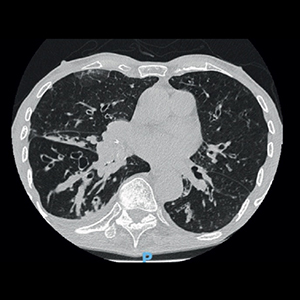Acute and long-term management of severe bronchiectasis with high flow nasal therapy: a case report

Submitted: May 20, 2022
Accepted: August 1, 2022
Published: August 4, 2022
Accepted: August 1, 2022
Abstract Views: 1829
PDF: 675
Publisher's note
All claims expressed in this article are solely those of the authors and do not necessarily represent those of their affiliated organizations, or those of the publisher, the editors and the reviewers. Any product that may be evaluated in this article or claim that may be made by its manufacturer is not guaranteed or endorsed by the publisher.
All claims expressed in this article are solely those of the authors and do not necessarily represent those of their affiliated organizations, or those of the publisher, the editors and the reviewers. Any product that may be evaluated in this article or claim that may be made by its manufacturer is not guaranteed or endorsed by the publisher.
Similar Articles
- Muhammad Ijaz, Muhammad Jaffar Khan, Jawad Khan, . Usama, Association of clinical characteristics of patients presenting with influenza like illness or severe acute respiratory illness with development of acute respiratory distress syndrome , Monaldi Archives for Chest Disease: Vol. 87 No. 1 (2017)
- Gabriele Valli, Francesca De Marco, Maria Teresa Spina, Valentina Valeriano, Antonello Rosa, Valentina Minerva, Enrico Mirante, Maria Pia Ruggieri, Francesco Rocco Pugliese, A pilot study on the application of the current European guidelines for the management of acute coronary syndrome without elevation of ST segment (NSTEMI) in the Emergency Department setting in the Italian region Lazio , Monaldi Archives for Chest Disease: Vol. 82 No. 4 (2014): Cardiac series
- Michele Vitacca, Luca Barbano, Daniele Colombo, Olivia Leoni, Enrico Guffanti, Prevalence and variability of use of home mechanical ventilators, positive airway pressure and oxygen devices in the Lombardy region, Italy , Monaldi Archives for Chest Disease: Vol. 88 No. 1 (2018)
- Roberto F.E. Pedretti, Francesco Fattirolli, Raffaele Griffo, Marco Ambrosetti, Elisabetta Angelino, Silvia Brazzo, Ugo Corrà , Nicolò Dasseni, Pompilio Faggiano, Giuseppe Favretto, Oreste Febo, Marina Ferrari, Francesco Giallauria, Cesare Greco, Manuela Iannucci, Maria Teresa La Rovere, Mario Mallardo, Antonio Mazza, Massimo Piepoli, Carmine Riccio, Simonetta Scalvini, Luigi Tavazzi, Pier Luigi Temporelli, Gian Francesco Mureddu, Cardiac Prevention and Rehabilitation “3.0â€: From acute to chronic phase. Position Paper of the ltalian Association for Cardiovascular Prevention and Rehabilitation (GICR-IACPR) , Monaldi Archives for Chest Disease: Vol. 88 No. 3 (2018)
- Massimiliano Polastri, Lara Pisani, Andrea Dell'Amore, Stefano Nava, Revolving door respiratory patients: A rehabilitative perspective , Monaldi Archives for Chest Disease: Vol. 87 No. 3 (2017)
- D. Scala, S. Cozzolino, G. D’Amato, G. Cocco, A. Sena, P. Martucci, E. Ferraro, A.A. Mancini, Sharing knowledge is the key to success in a patient-physician relationship: how to produce a patient information leaflet on COPD , Monaldi Archives for Chest Disease: Vol. 69 No. 2 (2008): Pulmonary series
- Paolo Ruggeri, Federica Lo Bello, Francesco Nucera, Michele Gaeta, Francesco Monaco, Gaetano Caramori, Giuseppe Girbino, Hereditary hyperhomocysteinemia associated with nephrotic syndrome complicated by artery thrombosis and chronic thromboembolic pulmonary hypertension: A case report , Monaldi Archives for Chest Disease: Vol. 87 No. 3 (2017)
- G. Caramori, M. Fabbri, D. Paioli, F. Falcone, C. Severino, G. Felisatti, O. Arar, I.M. Adcock, K. Fan Chung, P.J. Barnes, A. Ciaccia, A. Papi, Asthma is not a common cause of severe chronic respiratory failure in non-smokers: ALOT study , Monaldi Archives for Chest Disease: Vol. 63 No. 2 (2005): Pulmonary series
- Mauro Di Bari, Alessandra Pratesi, Francesca M. Nigro, Irene Marozzi, Stefano Fumagalli, DAPT plus anticoagulant therapy: The difficult coexistence post-ACS in older patients with atrial fibrillation , Monaldi Archives for Chest Disease: Vol. 88 No. 2 (2018)
- Claudio F. Donner, Sandro Amaducci, Elena Bacci, Sandra Baldacci, Maria L. Bartoli, Gianfranco M. Beghi, Alida Benfante, Sara Brighindi, Lucio Casali, Daniela Castiglia, Mario Cazzola, Alessandro Celi, Silvana Cianchetti, Giorgio Colombo, Claudia Crimi, Federico L. Dente, Giuseppe Di Maria, Annalisa Di Maria, Manuela Latorre, Federico Lavorini, Sara Maio, Claudia Mannini, Riccardo Messina, Pier Luigi Paggiaro, Patrizia Pignatti, David Price, Nicola Scichilone, Marzia Simoni, Antonio Spanevello, Martina Stagno d’Alcontres, Shawna Tan, Roberto Torchio, Giovanni Viegi, Dina Visca, Emiel F.M. Wouters, Shaylynn Yu Hui Xin, Inhalation therapy in the next decade: Determinants of adherence to treatment in asthma and COPD , Monaldi Archives for Chest Disease: Vol. 88 No. 1 (2018)
You may also start an advanced similarity search for this article.

 https://doi.org/10.4081/monaldi.2022.2333
https://doi.org/10.4081/monaldi.2022.2333





